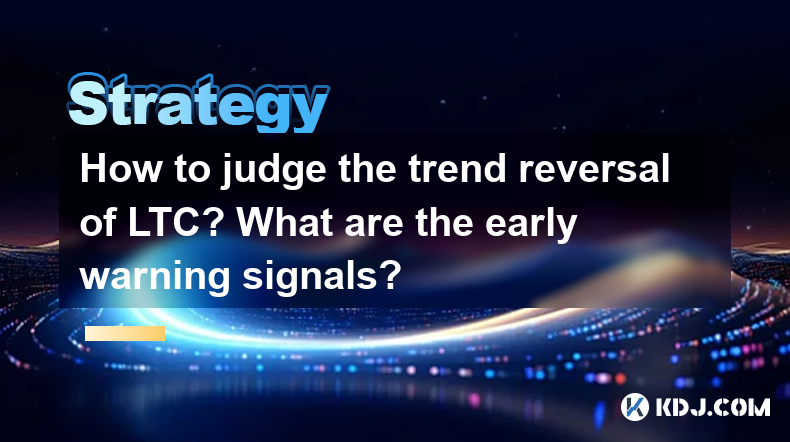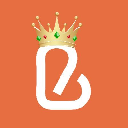-
 bitcoin
bitcoin $107208.295278 USD
-1.54% -
 ethereum
ethereum $3874.629914 USD
-1.38% -
 tether
tether $1.000440 USD
0.03% -
 bnb
bnb $1089.465513 USD
-5.53% -
 xrp
xrp $2.327672 USD
-1.65% -
 solana
solana $184.766505 USD
-0.73% -
 usd-coin
usd-coin $1.000076 USD
0.02% -
 tron
tron $0.310632 USD
-1.99% -
 dogecoin
dogecoin $0.187615 USD
-1.60% -
 cardano
cardano $0.633389 USD
-2.75% -
 ethena-usde
ethena-usde $0.999553 USD
0.03% -
 hyperliquid
hyperliquid $35.608231 USD
-4.13% -
 chainlink
chainlink $16.876114 USD
-3.98% -
 stellar
stellar $0.312239 USD
-0.91% -
 bitcoin-cash
bitcoin-cash $473.262969 USD
-7.09%
How to judge the trend reversal of LTC? What are the early warning signals?
Use moving averages, RSI, MACD, and chart patterns to spot LTC trend reversals; confirm with volume spikes and divergence for accurate predictions.
Apr 30, 2025 at 01:00 am

Understanding LTC Trend Reversals
LTC, or Litecoin, is one of the most established cryptocurrencies in the market. Understanding its trend reversals is crucial for traders and investors looking to maximize their returns. A trend reversal in LTC indicates a shift from a bullish to a bearish trend or vice versa. Recognizing these reversals early can help in making informed trading decisions.
Key Indicators for LTC Trend Reversals
To judge the trend reversal of LTC, several technical indicators and chart patterns can be used. These indicators serve as early warning signals that a reversal might be imminent. Here are some of the most reliable indicators:
- Moving Averages: The crossover of short-term and long-term moving averages can signal a trend reversal. For instance, when a short-term moving average (like the 50-day MA) crosses below a long-term moving average (like the 200-day MA), it may indicate a bearish reversal.
- Relative Strength Index (RSI): The RSI measures the speed and change of price movements. An RSI reading above 70 suggests that LTC might be overbought and due for a bearish reversal, while a reading below 30 indicates it might be oversold and due for a bullish reversal.
- MACD (Moving Average Convergence Divergence): The MACD is used to spot changes in the strength, direction, momentum, and duration of a trend in LTC's price. A bearish crossover (when the MACD line crosses below the signal line) can indicate a potential bearish reversal, and vice versa for a bullish crossover.
- Chart Patterns: Patterns like head and shoulders, double tops, and double bottoms can also signal trend reversals. For example, a head and shoulders pattern at the top of an uptrend can indicate a bearish reversal.
Early Warning Signals for LTC Trend Reversals
Early warning signals are crucial for traders to anticipate and prepare for potential trend reversals. Here are some specific signals to watch for:
- Volume Spikes: A sudden increase in trading volume can indicate that a trend reversal is about to occur. If LTC's price starts to decline with high volume, it might be a sign of a bearish reversal.
- Divergence: When the price of LTC is moving in the opposite direction of an indicator like the RSI or MACD, it can signal a potential reversal. For example, if LTC's price is making higher highs but the RSI is making lower highs, this bearish divergence can indicate a reversal.
- Break of Support/Resistance Levels: If LTC breaks below a key support level or above a key resistance level, it can signal a trend reversal. These levels are often identified using historical price data and technical analysis tools.
Practical Steps to Identify LTC Trend Reversals
Identifying trend reversals in LTC involves a combination of technical analysis and market observation. Here are some practical steps to follow:
- Monitor Moving Averages: Use a charting platform to plot the 50-day and 200-day moving averages for LTC. Watch for crossovers between these averages as potential signals of trend reversals.
- Analyze RSI and MACD: Add the RSI and MACD indicators to your LTC chart. Look for overbought/oversold conditions and crossovers that might indicate a reversal.
- Identify Chart Patterns: Regularly scan LTC's price chart for patterns like head and shoulders, double tops, and double bottoms. Use drawing tools to mark these patterns and set alerts for potential breakouts.
- Track Volume: Keep an eye on LTC's trading volume. Use volume indicators to identify spikes that could signal a reversal.
- Watch for Divergence: Compare LTC's price movements with indicators like RSI and MACD. Look for instances where the price and the indicator are moving in opposite directions.
- Set Alerts for Support/Resistance Levels: Use your trading platform to set price alerts at key support and resistance levels. A break of these levels can signal a trend reversal.
Using Technical Analysis Tools for LTC Trend Reversals
Technical analysis tools are essential for identifying trend reversals in LTC. Here's how to use some of these tools effectively:
- Candlestick Charts: Candlestick charts provide a visual representation of LTC's price movements. Look for patterns like doji, hammer, and shooting star, which can indicate potential reversals.
- Fibonacci Retracement: Use Fibonacci retracement levels to identify potential support and resistance levels. A break of these levels can signal a trend reversal.
- Trend Lines: Draw trend lines on LTC's price chart to identify the current trend. A break of a trend line can indicate a reversal.
- Bollinger Bands: Bollinger Bands can help identify overbought and oversold conditions. A move outside the bands can signal a potential reversal.
Combining Multiple Indicators for Confirmation
To increase the accuracy of predicting LTC trend reversals, it's important to combine multiple indicators and signals. Here's how to do it:
- Confirm with Volume: If a potential reversal signal is identified using moving averages or chart patterns, confirm it with a volume spike. High volume can validate the signal.
- Check for Divergence: If a reversal signal is identified using RSI or MACD, check for divergence between the price and the indicator. Divergence can strengthen the signal.
- Look for Multiple Patterns: If a chart pattern like a head and shoulders is identified, look for additional patterns or indicators that confirm the reversal. For example, a bearish crossover of the MACD can confirm a bearish head and shoulders pattern.
- Use Multiple Timeframes: Analyze LTC's price on different timeframes (e.g., daily, weekly, monthly) to confirm the reversal signal. A signal that appears on multiple timeframes is more reliable.
Frequently Asked Questions
Q: Can fundamental analysis be used to predict LTC trend reversals?A: While fundamental analysis can provide insights into LTC's long-term value, it is less effective for predicting short-term trend reversals. Technical analysis, which focuses on price movements and chart patterns, is more suitable for identifying trend reversals in LTC.
Q: How often should I check for trend reversal signals in LTC?A: The frequency of checking for trend reversal signals depends on your trading strategy. For short-term traders, daily or even hourly checks might be necessary. For long-term investors, weekly or monthly checks may be sufficient.
Q: Are there any specific tools or platforms recommended for analyzing LTC trend reversals?A: Several platforms offer robust tools for analyzing LTC trend reversals, including TradingView, Coinigy, and CryptoWatch. These platforms provide advanced charting capabilities, technical indicators, and real-time data, which are essential for identifying trend reversals.
Q: How can I differentiate between a trend reversal and a temporary price correction in LTC?A: Differentiating between a trend reversal and a temporary price correction can be challenging. A trend reversal is typically confirmed by multiple indicators and signals, such as moving average crossovers, chart patterns, and volume spikes. A temporary price correction, on the other hand, often lacks these confirmations and may quickly revert to the original trend.
Disclaimer:info@kdj.com
The information provided is not trading advice. kdj.com does not assume any responsibility for any investments made based on the information provided in this article. Cryptocurrencies are highly volatile and it is highly recommended that you invest with caution after thorough research!
If you believe that the content used on this website infringes your copyright, please contact us immediately (info@kdj.com) and we will delete it promptly.
- Bitcoin, Crypto Coins, and 2025: What's the Hype?
- 2025-10-19 06:25:15
- Dogwifhat's Price Stabilization: Is a Reversal Rally on the Horizon?
- 2025-10-19 06:45:13
- Uniswap's UNI Navigates Open Interest Dip: What's Next?
- 2025-10-19 06:45:13
- Solana, TVL, and Meme Coins: A New Era?
- 2025-10-19 06:25:15
- Steve Jobs, American Innovation, and a $1 Coin: A New York State of Mind
- 2025-10-19 06:50:11
- Meme Coins: Buy Now or Wait? Presale Trends and Future Insights
- 2025-10-19 06:30:15
Related knowledge

Practical parameter settings for a Bitcoin multi-timeframe moving average system
Sep 18,2025 at 10:54pm
Optimizing Timeframe Combinations for Bitcoin Trading1. Selecting appropriate timeframes is crucial when building a multi-timeframe moving average sys...

How can I filter out false breakouts in Dogecoin high-frequency trading?
Sep 22,2025 at 01:00am
Understanding False Breakouts in Dogecoin Trading1. A false breakout occurs when Dogecoin's price appears to move beyond a defined support or resistan...

Techniques for identifying tops and bottoms in the Bitcoin on-chain NVT model
Sep 20,2025 at 07:54pm
Understanding the NVT Model in Bitcoin Analysis1. The Network Value to Transactions (NVT) ratio is often described as the 'P/E ratio' of the cryptocur...

What does the surge in open interest in Bitcoincoin futures mean?
Sep 20,2025 at 11:18pm
Understanding the Surge in Dogecoin Futures Open Interest1. A surge in open interest within Dogecoin futures indicates a growing number of active cont...

How can I use the Ethereum USDT premium to gauge market sentiment?
Sep 18,2025 at 11:55pm
Understanding the Ethereum USDT Premium1. The Ethereum USDT premium refers to the price difference between USDT (Tether) traded on Ethereum-based plat...

What should I do if Ethereum staking yields decline?
Sep 20,2025 at 06:18am
Understanding the Causes Behind Declining Ethereum Staking Yields1. The Ethereum network transitioned to a proof-of-stake consensus mechanism with the...

Practical parameter settings for a Bitcoin multi-timeframe moving average system
Sep 18,2025 at 10:54pm
Optimizing Timeframe Combinations for Bitcoin Trading1. Selecting appropriate timeframes is crucial when building a multi-timeframe moving average sys...

How can I filter out false breakouts in Dogecoin high-frequency trading?
Sep 22,2025 at 01:00am
Understanding False Breakouts in Dogecoin Trading1. A false breakout occurs when Dogecoin's price appears to move beyond a defined support or resistan...

Techniques for identifying tops and bottoms in the Bitcoin on-chain NVT model
Sep 20,2025 at 07:54pm
Understanding the NVT Model in Bitcoin Analysis1. The Network Value to Transactions (NVT) ratio is often described as the 'P/E ratio' of the cryptocur...

What does the surge in open interest in Bitcoincoin futures mean?
Sep 20,2025 at 11:18pm
Understanding the Surge in Dogecoin Futures Open Interest1. A surge in open interest within Dogecoin futures indicates a growing number of active cont...

How can I use the Ethereum USDT premium to gauge market sentiment?
Sep 18,2025 at 11:55pm
Understanding the Ethereum USDT Premium1. The Ethereum USDT premium refers to the price difference between USDT (Tether) traded on Ethereum-based plat...

What should I do if Ethereum staking yields decline?
Sep 20,2025 at 06:18am
Understanding the Causes Behind Declining Ethereum Staking Yields1. The Ethereum network transitioned to a proof-of-stake consensus mechanism with the...
See all articles










































































